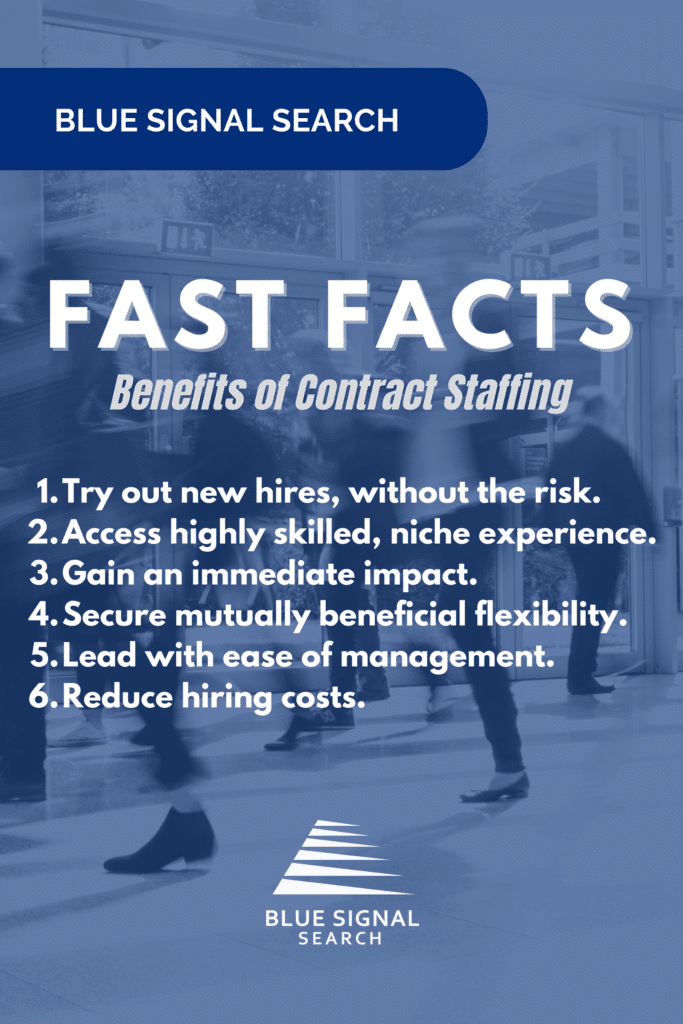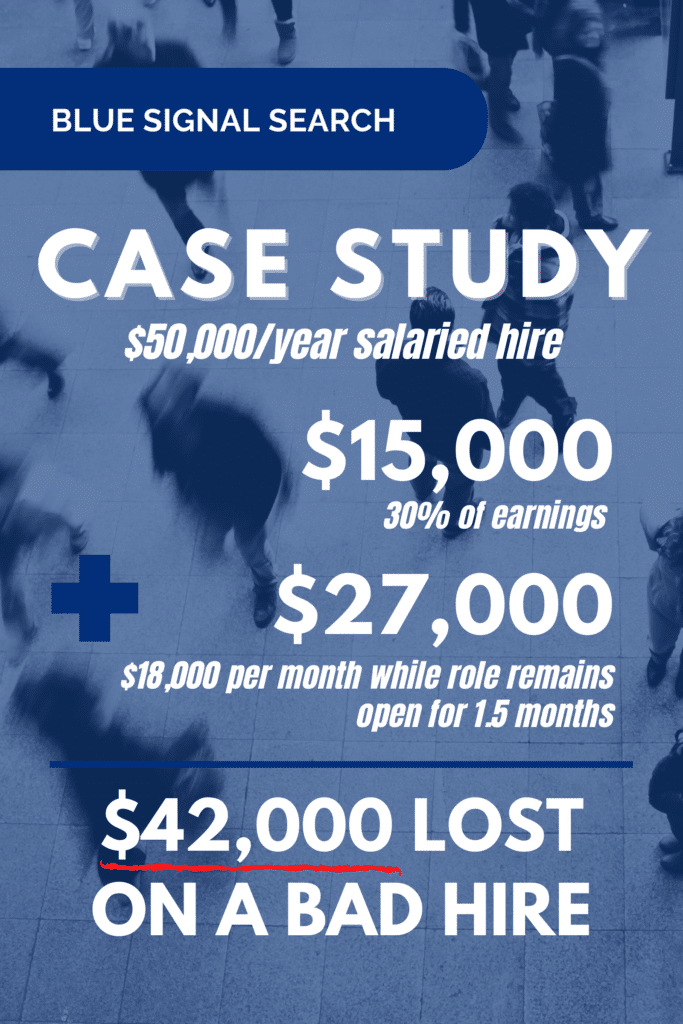Making the decision to hire is the easy part. Whether you have a busy season that calls for increased workloads, are starting a new project, or have a hole in your ranks - it’s easy to tell when it’s time to bring new talent on board. The hard part? Deciding how to make this hire. After ironing out your budget, the role’s responsibilities, and the timeline you need to hit to match your urgency, you’ll have to decide the type of hire you want to make.
There are several benefits to making a permanent hire - but what you don’t often hear about is the benefits of hiring someone on a temporary basis. Ultimately, you must decide what it is you want to accomplish with this hire. Leverage this list of top 6 benefits to find out if contract staffing is right for this position, and prioritize what it is your organization needs from this addition to the team.
1. "Try out” new hires - without the risk
In some cases, making a new hire might impose a great risk on your organization. Maybe you have never hired someone for this role before, or perhaps the business needs the help but is in a precarious financial situation. Bad hires can cost organizations up to 30% of the employee’s first-year earnings, according to the US Department of Labor. CareerBuilder found that this averaged around $14,900 per poor hire. While the ultimate goal is to find an amazing fit for the organization and need, sometimes the candidate just isn’t suitable for the role. By hiring on a temporary or contract basis before fully committing to a permanent hire, you are limiting your risk, exposure, and staffing costs.
The temp-to-hire model gives the best insight into the success of the role and/or the employee! Better yet, it gives you time to build out your organization in the event of a new reporting structure or team. Say you were creating an entirely new business unit and trying to decide whether or not a job function should be split into two roles - having a temporary contractor on board could give you insight into the role’s bandwidth. The contractor can give their honest feedback without fear of it hurting their position, and it protects future full-time employees from taking on too much of the strain of growing pains. The insight is endless!
2. Access highly skilled, niche experience
Contractors generally have more of a project-based background. While the typical hiring model gives preference to years of experience, it really leaves out the advantage that these contractors possess. They were brought into organizations for their expertise - and in a shorter time frame have touched more software and variables, while gaining more insight into that area of focus than the usual full-time employee. They didn’t have to be taught overall company processes, the ins and outs of the business, and so on - they spent their time handling the issues at hand. By having shorter job stints, with more focus on the project than the overall organization, you are able to tap into niche experience without the looming price tag of a long-term salary contract.
Consultants are a superb resource for project-based initiatives. Say you have a large systems conversion that is estimated to take 1-2 years to complete. A consultant can bring hyper-specialized expertise to the organization and get the project done right. In the end, you aren’t stuck with a specialist on a W2 when moving forward, a generalist would be more beneficial.

3. Gain an immediate impact
If you are looking to make a hire to complete a particular project or short-term job function, hiring a temp makes it easier to assign job duties and manage the scope of the role. You can easily narrow the role to fit the particular venture. Whether your need comes from last-minute projects, increased workloads in a busy season, newly awarded contracts, and even employee absences - the temp hiring model can help bridge the gap. No team building, culture fit, company onboarding, or non-role related training required - especially when working with a staffing company or talent acquisition firm.
Recruiters can help qualify candidates on skillset and conduct background checks, making the hiring process virtually hands free. Contractors typically require little to no supervision or training, giving time back into the pockets of those managers and trainers you would otherwise need to schedule into the mix. This saves you time and effort - but protects candidates as well! They are able to jump into a position, build their skills, and not have to worry about the politics of a long-term role. They get to fast forward to the reason they are there - to build their skillset, utilize their knowledge, and make an immediate impact on an organization.
4. Secure mutually beneficial flexibility
Hiring temporary employees gives companies the ability to respond to market changes and business needs as they happen. As mentioned, contract workers can help bridge gaps and provide flexible coverage for a variety of needs. Hire when you need it, and don’t continue contracts when you don’t. The best part? This adaptability is beneficial to candidates as well.
One misconception of staffing is that it provides no job security on the employees’ end. However, with contracting they are able to truly select their work environment and choose which projects they would like to participate in. They can take roles based on the skills they want to gain, the expertise they hold - and if they get all they want out of a role, they can move to the next with no concern for “job hopping”. Contractors take advantage of this freedom by gaining marketable skills as the industry evolves - and achieve job security by staying ahead of the curve on the newest trends and technologies, while expanding their skillset portfolio.
5. Lead with ease of management
When working with talent acquisition agencies, the general management of the employee is usually left to those outside groups. You would only ever work with one recruiter - spelling out your requirements and leaving the discovery and qualification of candidates up to them. The recruiter will conduct the background checks, interviewing, qualification matching, and reference checks. Then, even after signing a contract and bringing them on board, most agencies will manage the candidate’s benefits administration, payroll, time-off requests, and insurance. For those publicly traded companies, this avoids the risk of finances and lowers your official headcount.
Further still, if the candidate isn’t working out, the end of the contract gives an easy way out without the emotional stress of a fire, and with no explanation needed. The contractor has these expectations set early. Worst case, they finish out what they were brought in to do then leave. Best case, you found a potential temp-to-hire without assuming any risk of making a blind full-time hire.
6. Reduce hiring costs
With contract staffing you only pay for what you want, when you need it. You pay for their hours worked, and the agency fee would cover their benefits and other finances. This fee is always much lower than the cost of a new permanent employee. The Society of Human Resource Management found that the average cost to onboard a new employee in 2020 is $4,129 - with 42 days to fill the position. That doesn’t factor in the cost of leaving a position open while looking for the right candidate. In 2019, the average cost per open role was $18,000 per month. Can you afford to wait 42 days - at $18,000 per 30 days - and then pay to onboard? Before a perm hire can make an impact on an organization, it’s likely that you’ve lost over $20K just in the process of getting them into a desk.

With staffing, you can drastically reduce that price tag. And with Blue Signal, our Staffing Division offers a 48-hour turnaround to get contractors hired fast. We match your level of urgency and can get staffing for your open roles quicker than it’d take to onboard a full-time employee. Contact us today to discuss your options, and see if contract staffing is right for your business. As your partner in the process, we specialize in a business’ most important aspect - talent.

